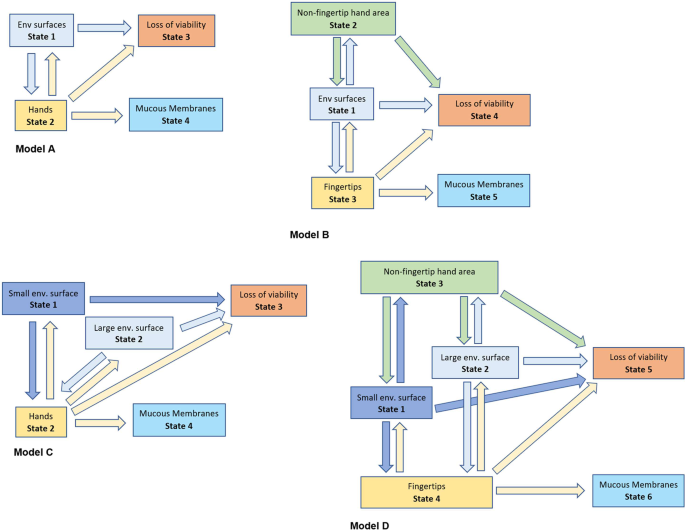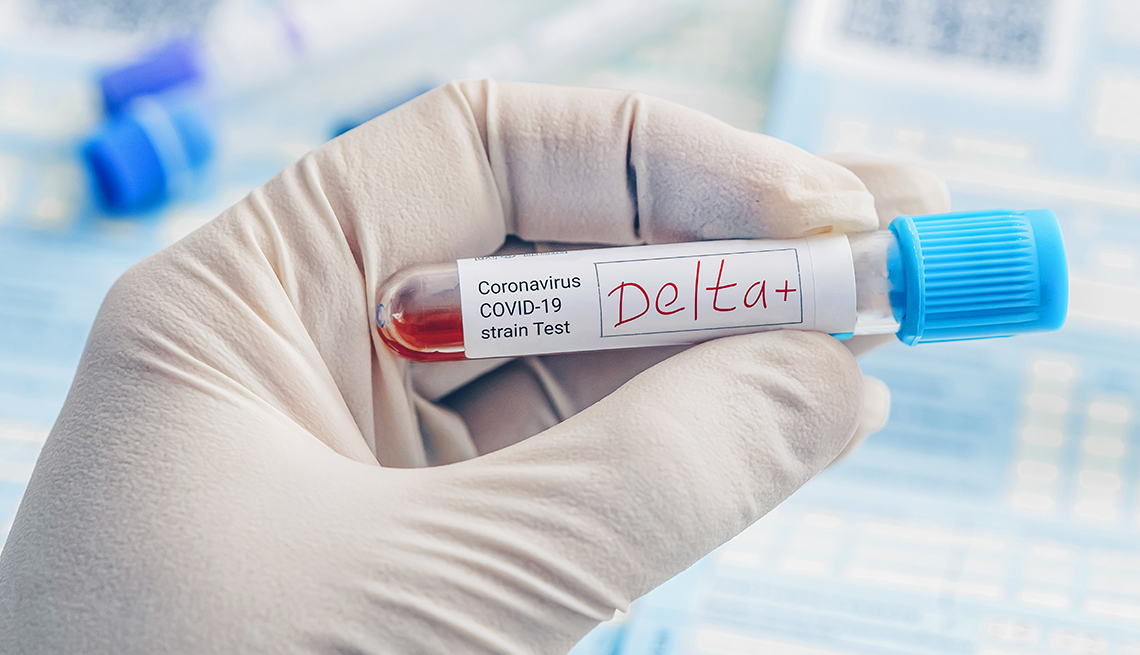
- Select a language for the TTS:
- UK English Female
- UK English Male
- US English Female
- US English Male
- Australian Female
- Australian Male
- Language selected: (auto detect) - EN
Play all audios:
ABSTRACT BACKGROUND When modeling exposures from contact with fomites, there are many choices in defining the sizes of compartments representing environmental surfaces and hands, and the
portions of compartments involved in contacts. These choices impact dose estimates, yet there is limited guidance for selection of these model parameters. OBJECTIVE The study objective was
to explore methods for representing environmental surface and hand contact areas in exposure models and implications for estimated doses. METHODS A simple scenario was used: an individual
using their hands to contact their face and two microbially contaminated environmental surfaces. Four models were developed to explore different compartmentalization strategies: (1) hands
and environmental surfaces each represented by one compartment, (2) hands represented by two compartments (fingertips vs. non-fingertip areas) while environmental surfaces were represented
by one compartment, (3) hands represented by a single compartment and environmental surfaces represented by two compartments, and (4) hands and environmental surfaces each represented by two
compartments. Sensitivity analyses were conducted to evaluate the influence of heterogeneous surface contact frequency, hand contact type, and hand dominance on dose. RESULTS Estimated
doses were greatest when hand areas and environmental surfaces were each represented by two compartments, indicating that surface area “dilutes” contaminant concentration and decreases
estimated dose. SIGNIFICANCE Model compartment designations for hands and environmental surfaces affect dose estimation, but more human behavior data are needed. IMPACT STATEMENT A common
problem for exposure models describing exposures via hand-to-surface contacts occurs in the way that estimated contamination across human skin (usually hands) or across environmental
surfaces is spatially averaged, as opposed to accounting for concentration changes across specific parts of the hand or individual surfaces. This can lead to the dilution of estimated
contaminants and biases in estimated doses in risk assessments. The magnitude of these biases and implications for the accuracy in risk assessments are unknown. We quantify differences in
dose for various strategies of compartmentalizing environmental surfaces and hands to inform guidance on future exposure model development. Access through your institution Buy or subscribe
This is a preview of subscription content, access via your institution ACCESS OPTIONS Access through your institution Subscribe to this journal Receive 6 print issues and online access
$259.00 per year only $43.17 per issue Learn more Buy this article * Purchase on SpringerLink * Instant access to full article PDF Buy now Prices may be subject to local taxes which are
calculated during checkout ADDITIONAL ACCESS OPTIONS: * Log in * Learn about institutional subscriptions * Read our FAQs * Contact customer support SIMILAR CONTENT BEING VIEWED BY OTHERS
EXPLORING TOILET PLUME BIOAEROSOL EXPOSURE DYNAMICS IN PUBLIC TOILETS USING A DESIGN OF EXPERIMENTS APPROACH Article Open access 09 May 2024 OCCUPATIONAL INHALATION EXPOSURE DURING SURFACE
DISINFECTION—EXPOSURE ASSESSMENT BASED ON EXPOSURE MODELS COMPARED WITH MEASUREMENT DATA Article Open access 25 December 2023 MODEL BASED PREDICTION OF AGE-SPECIFIC SOIL AND DUST INGESTION
RATES FOR CHILDREN Article Open access 17 January 2022 REFERENCES * Nicas M, Best D. A study quantifying the hand-to-face contact rate and its potential application to predicting respiratory
tract infection. J Occup Environ Hyg. 2008;5:347–52. Article PubMed PubMed Central Google Scholar * Wilson AM, Verhougstraete MP, Beamer PI, King M-F, Reynolds KA, Gerba CP. Frequency
of hand-to-head, -mouth, -eyes, and -nose contacts for adults and children during eating and non-eating macro-activities. J Expo Sci Environ Epidemiol. 2021;31:34–44. Article PubMed Google
Scholar * Rahman J, Mumin J, Fakhruddin B. How frequently do we touch facial T-zone: a systematic review. Ann Glob Heal. 2020;86:75. Article Google Scholar * Julian TR, Canales RA,
Leckie JO, Boehm AB. A model of exposure to rotavirus from nondietary ingestion iterated by simulated intermittent contacts. Risk Anal. 2009;29:617–32. Article PubMed Google Scholar * Xue
J, Zartarian V, Moya J, Freeman N, Beamer P, Black K, et al. A meta-analysis of children’s hand-to-mouth frequency data for estimating nondietary ingestion exposure. Risk Anal.
2007;27:411–20. Article PubMed Google Scholar * Hubal EAC, Suggs JC, Nishioka G, Ivancic WA. Characterizing residue transfer efficiencies using a fluorescent imaging technique. J Expo
Anal Environ Epidemiol. 2005;15:261–70. Article Google Scholar * Sahmel J, Hsu EI, Avens HJ, Beckett EM, Devlin KD. Estimation of hand-to-mouth transfer efficiency of lead. Ann Work Expo
Heal. 2015;59:210–20. CAS Google Scholar * Hauptman M, Bruccoleri R, Woolf AD. An update on childhood Lead poisoning. Clin Pediatr Emerg Med. 2018;18:181–92. Article Google Scholar *
Zartarian VG, Ozkaynak H, Burke JM, Zufall MJ, Rigas ML, Furtaw E. A modeling framework for estimating children’s residential exposure and dose to chlorpyrifos via dermal residue contact and
nondietary ingestion. Environ Health Perspect. 2000;108:505–14. Article CAS PubMed PubMed Central Google Scholar * Beamer PI, Canales RA, Ferguson AC, Leckie JO. Relative pesticide and
exposure route contribution to aggregate and cumulative dose in young farmworker children. Int J Environ Res Public Health. 2012;9:73–96. Article CAS PubMed PubMed Central Google
Scholar * Ryan MO, Haas CN, Gurian PL, Gerba CP, Panzl BM, Rose JB. Application of quantitative microbial risk assessment for selection of microbial reduction targets for hard surface
disinfectants. Am J Infect Control. 2014;42:1165–72. Article CAS PubMed Google Scholar * Wilson AM, King M-F, López-García M, Clifton I, Proctor J, Reynolds KA, et al. Effects of patient
room layout on viral accruement on healthcare workers’ hands. Indoor Air. 2021;31:1657–72. Article CAS PubMed PubMed Central Google Scholar * King M-F, Noakes CJ, Sleigh PA. Modeling
environmental contamination in hospital single- and four-bed rooms. Indoor Air. 2015;25:694–707. Article CAS PubMed PubMed Central Google Scholar * Beamer PI, Plotkin KR, Gerba CP,
Sifuentes LY, Koenig DW, Reynolds KA. Modeling of human viruses on hands and risk of infection in an office workplace using micro-activity data. J Occup Environ Hyg. 2015;12:266–75. Article
CAS PubMed PubMed Central Google Scholar * Jones RM. Relative contributions of transmission routes for COVID-19 among healthcare personnel providing patient care. J Occup Environ Hyg.
2020;17:408–15. Article CAS PubMed Google Scholar * Kraay ANM, Hayashi MAL, Hernandez-Ceron N, Spicknall IH, Eisenberg MC, Meza R, et al. Fomite-mediated transmission as a sufficient
pathway: a comparative analysis across three viral pathogens. BMC Infect Dis. 2018;18:540. Article PubMed PubMed Central Google Scholar * Pitol AK, Julian TR. Community transmission of
SARS-CoV-2 by surfaces: risks and risk reduction strategies. Environ Sci Technol Lett. 2021;8:263–269. Article CAS Google Scholar * AuYeung W, Canales RA, Leckie JO. The fraction of total
hand surface area involved in young children’s outdoor hand-to-object contacts. Environ Res. 2008;108:294–9. Article CAS PubMed Google Scholar * King M-F, Wilson AM, López-García M,
Proctor J, Peckham DG, Clifton IJ, et al. Why is mock care not a good proxy for predicting hand contamination during patient care? J Hosp Infect. 2021;109:44–51. Article CAS PubMed Google
Scholar * Beamer PI, Luik CE, Canales RA, Leckie JO. Quantified outdoor micro-activity data for children aged 7 – 12-years old. J Expo Sci Environ Epidemiol. 2012;22:82–92. Article PubMed
Google Scholar * Hubal EAC, Sheldon LS, Burke JM, McCurdy TR, Berry MR, Rigas ML, et al. Children’s exposure assessment: A review of factors influencing children’s exposure, and the data
available to characterize and assess that exposure. Environ Health Perspect. 2000;108:475–86. Article Google Scholar * Canales RA The cumulative and aggregate simulation of exposure
framework. Stanford University; 2004. PhD dissertation. * King M-F, Wilson AM, Weir MH, Lopez-Garcia M, Proctor J, Hiwar W, et al. Modelling the risk of SARS-CoV-2 infection through PPE
doffing in a hospital environment. Indoor Air. 2021; Available from: https://doi.org/10.1111/ina.12938. * Harvey AP, Fuhrmeister ER, Cantrell M, Pitol AK, Swarthout JM, Powers JE, et al.
Longitudinal monitoring of SARS-CoV-2 RNA on high-touch surfaces in a community setting. Environ Sci Technol Lett. 2021;8:168–175. Article CAS PubMed Google Scholar * Wilson AM, Weir MH,
Bloomfield SA, Scott EA, Reynolds KA. Modeling COVID-19 infection risks for a single hand-to-fomite scenario and potential risk reductions offered by surface disinfection. Am J Infect
Control. 2021;49:846–848. Article CAS PubMed Google Scholar * Weir MH, Shibata T, Masago Y, Cologgi DL, Rose JB. Effect of surface sampling and recovery of viruses and non-spore-forming
bacteria on a quantitative microbial risk assessment model for fomites. Environ Sci Technol. 2016;50:5945–52. Article CAS PubMed PubMed Central Google Scholar * Zhang N, Jia W, Wang P,
King M-F, Chan P-T, Li Y. Most self-touches are with the nondominant hand. Sci Rep. 2020;10:10457. Article CAS PubMed PubMed Central Google Scholar * Phan LT, Maita D, Mortiz DC,
Bleasdale SC, Jones RM. Environmental contact and self-contact patterns of healthcare workers: Implications for infection prevention and control. Clin Infect Dis. 2019;69:S178–84. Article
CAS PubMed Google Scholar * Smith SJ, Young V, Robertson C, Dancer SJ. Where do hands go? An audit of sequential hand-touch events on a hospital ward. J Hosp Infect. 2012;80:206–11.
Article CAS PubMed Google Scholar * Adams CE, Smith J, Watson V, Robertson C, Dancer SJ. Examining the association between surface bioburden and frequently touched sites in intensive
care. J Hosp Infect. 2017;95:76–80. Article CAS PubMed Google Scholar * Wilson AM, King M-F, López-García M, Weir MH, Sexton JD, Canales RA, et al. Evaluating a transfer gradient
assumption in a fomite-mediated microbial transmission model using an experimental and Bayesian approach. J R Soc Interface. 2020;17:20200121. Article PubMed PubMed Central Google Scholar
* Lopez GU, Gerba CP, Tamimi AH, Kitajima M, Maxwell SL, Rose JB. Transfer efficiency of bacteria and viruses from porous and nonporous fomites to fingers under different relative
humidity. Appl Environ Microbiol. 2013;79:5728–34. Article CAS PubMed PubMed Central Google Scholar * Rusin P, Maxwell S, Gerba C. Comparative surface-to-hand and fingertip-to-mouth
transfer efficiency of gram-positive bacteria, gram-negative bacteria, and phage. J Appl Microbiol. 2002;93:585–92. Article CAS PubMed Google Scholar * King M-F, López-García M, Atedoghu
KP, Zhang N, Wilson AM, Weterings M, et al. Bacterial transfer to fingertips during sequential surface contacts with and without gloves. Indoor Air. 2020;30:993–1004. Article PubMed
Google Scholar * Julian TR, Leckie JO, Boehm AB. Virus transfer between fingerpads and fomites. J Appl Microbiol. 2010;109:1868–74. Article CAS PubMed Google Scholar * Clothier JM
Dermal transfer efficiency of pesticides from new, vinyl sheet flooring to dry and wetted palms. 2000. Available from:
https://nepis.epa.gov/Exe/ZyNET.exe/P100GN80.txt?ZyActionD=ZyDocument&Client=EPA&Index=2000Thru2005&Docs=&Query=%28palm%29ORFNAME%3D%22P100GN80.txt%22ANDFNAME%3D%22P100GN80.txt%22&Time=&EndTime=&SearchMethod=1&TocRestrict=n&Toc=&TocEntry=&QField=&QF.
Accessed on June 24, 2021. * Hubal EAC, Nishioka MG, Ivancic WA, Morara M, Egeghy PP. Comparing surface residue transfer efficiencies to hands using polar and nonpolar fluorescent tracers.
Environ Sci Technol. 2008;42:934–9. Article PubMed Google Scholar * Chatagny P, Badoud S, Kaeser M, Gindrat A-D, Savidan J, Fregosi M, et al. Distinction between hand dominance and hand
preference in primates: a behavioral investigation of manual dexterity in nonhuman primates (macaques) and human subjects. Brain Behav. 2013;3:575–95. Article PubMed PubMed Central Google
Scholar * van Doremalen N, Bushmaker T, Morris DH, Holbrook MG, Gamble A, Williamson BN, et al. Aerosol and surface stability of SARS-CoV-2 as compared with SARS-CoV-1. N Engl J Med.
2020;382:1564–7. Article PubMed Google Scholar * Harbourt DE, Haddow AD, Piper AE, Bloomfield H, Kearney BJ, Fetterer D, et al. Modeling the stability of severe acute respiratory syndrome
coronavirus 2 (SARS-CoV- 2) on skin, currency, and clothing. PLoS Negl Trop Dis. 2020;14:e0008831. Article CAS PubMed PubMed Central Google Scholar * U.S. Environmental Protection
Agency. Exposure Factors Handbook 2011 Edition (EPA/600/R-09/052F) [Internet]. Washington, DC; 2011. Available from: https://cfpub.epa.gov/ncea/risk/recordisplay.cfm?deid=236252. Accessed on
June 24, 2021. Download references ACKNOWLEDGEMENTS Code is accessible via: https://github.com/awilson12/dilution_model_comparison. AM Wilson was supported by the Rocky Mountain Center for
Occupational and Environmental Health (CDC/NIOSH T42/OH008414). AUTHOR INFORMATION AUTHORS AND AFFILIATIONS * Rocky Mountain Center for Occupational and Environmental Health, University of
Utah, Salt Lake City, UT, USA Amanda M. Wilson & Rachael M. Jones * Department of Family and Preventive Medicine, School of Medicine, University of Utah, Salt Lake City, UT, USA Amanda
M. Wilson & Rachael M. Jones * Department of Community, Environment & Policy, Mel and Enid Zuckerman College of Public Health, University of Arizona, Tucson, AZ, 85721, USA Amanda M.
Wilson Authors * Amanda M. Wilson View author publications You can also search for this author inPubMed Google Scholar * Rachael M. Jones View author publications You can also search for
this author inPubMed Google Scholar CONTRIBUTIONS AW and RJ contributed to the intellectual development and writing of the manuscript. AW led coding development. CORRESPONDING AUTHOR
Correspondence to Amanda M. Wilson. ETHICS DECLARATIONS COMPETING INTERESTS The authors declare no competing interests. ADDITIONAL INFORMATION PUBLISHER’S NOTE Springer Nature remains
neutral with regard to jurisdictional claims in published maps and institutional affiliations. SUPPLEMENTARY INFORMATION SUPPLEMENTARY MATERIAL RIGHTS AND PERMISSIONS Reprints and
permissions ABOUT THIS ARTICLE CITE THIS ARTICLE Wilson, A.M., Jones, R.M. Exploring spatial averaging of contamination in fomite microbial transfer models and implications for dose. _J Expo
Sci Environ Epidemiol_ 32, 759–766 (2022). https://doi.org/10.1038/s41370-021-00398-2 Download citation * Received: 24 June 2021 * Revised: 19 October 2021 * Accepted: 21 October 2021 *
Published: 06 November 2021 * Issue Date: September 2022 * DOI: https://doi.org/10.1038/s41370-021-00398-2 SHARE THIS ARTICLE Anyone you share the following link with will be able to read
this content: Get shareable link Sorry, a shareable link is not currently available for this article. Copy to clipboard Provided by the Springer Nature SharedIt content-sharing initiative
KEYWORDS * Fomite transmission * risk assessment * infectious disease modeling



:max_bytes(150000):strip_icc():focal(319x0:321x2)/people_social_image-60e0c8af9eb14624a5b55f2c29dbe25b.png)



